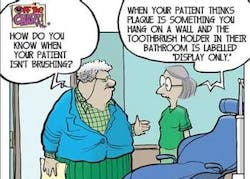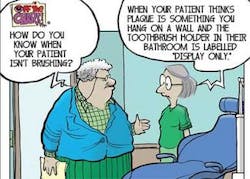Reader's Forum
Dear RDH:
I thank Diane Daubert, RDH, MS, for bringing more awareness (see Readers' Forum, September 2009 issue) to the very important topic in the July 2009 issue of RDH, "Hygiene and the Implant Patient."
I am responding to each issue Ms. Daubert has:
• A periodontally healthy patient is the goal. There are many different modalities of treatment that could be utilized to achieve this goal. Each patient has different medical, dental, and other habits that must be considered. A hygienist is assessing each patient to decide what type of treatment would be needed and considered to create a healthy periodontal status. Times are changing and methods of treatment are changing. Pubmed.gov has current information regarding laser therapy and the use of chlorhexidine.
• Regarding probe readings, as we are all aware, the research and facts regarding the composition and quality of tissues around teeth and implants are different. It is important not to disrupt the connective tissue attachment that can cause a "plaque trap." Plaque is extremely disruptive, especially to the implant due to the lack of fibroblasts, and the increase in the duration of inflammation and plaque progresses apically around the implant. This is research by Dr. Berglundh et al.
If a hygienist feels he or she wants to take the chance of disrupting the very delicate connective tissue attachment around the implant with repetitive probe readings, possibly creating an environment for plaque to develop and grow, to possibly be the cause of a failed implant, then go ahead and take that chance ...
Thank you for bringing attention to this very important topic.
Ann M. Drewenski, RDH
Dyer, Indiana
Dear RDH:
The article by Eva M. Watson, RDH, titled, "The HMO Experience, How to Survive the Mill," in your October issue of RDH was a disturbing read. That you should include it as a highlighted cover article makes me question your understanding of our profession. What Ms. Watson is supporting, through her agreeing to be employed in this office, is insurance fraud, patient neglect and a complete disregard for her education and this profession. She is allowing her employer to check off the box that states a prophylaxis was performed. All health care providers at this office must fully understand that this was neither professionally nor appropriately provided.
Our office went through the challenges of providing HMO services. At the time, our appointments were 45 minutes. As the backlog of patients grew, the HMO strongly suggested that the hygienists needed to "work more efficiently" with 30–minute appointments. Our office left the group. We now have one–hour appointments, and I am still wishing for more time. I have been a health care provider for nearly 40 years and proud of every one of them. This article will not make any of us proud. To include this article which advocates that new graduates consider this environment in order to learn to "work more efficiently" is irresponsible of your journal.
Susan Lopez, RDH
Mountain View, California

